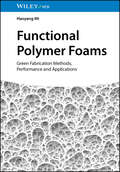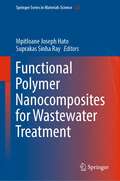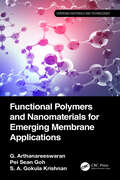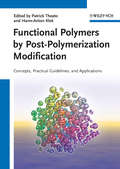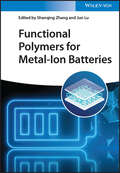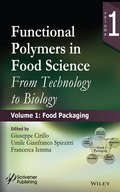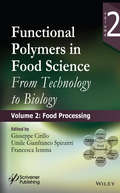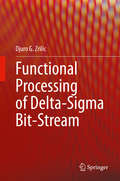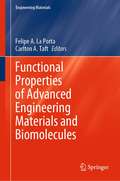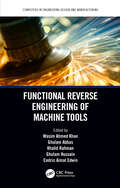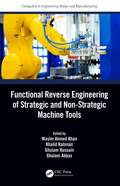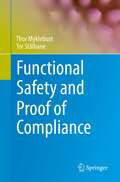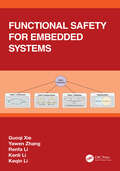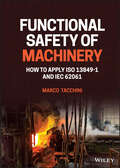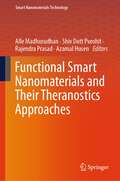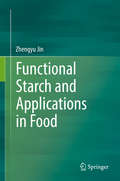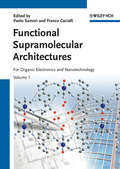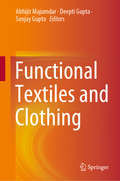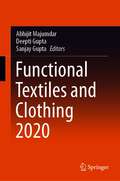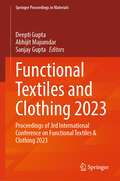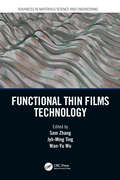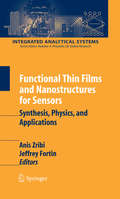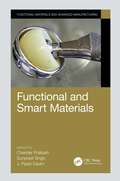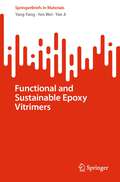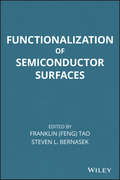- Table View
- List View
Functional Polymer Foams: Green Fabrication Methods, Performance and Applications
by Haoyang MiA one-of-a-kind exploration of the fundamentals of functional polymer foams, including their fabrication and a variety of their most common applications In Functional Polymer Foams: Green Fabrication Methods, Performance and Applications, distinguished researcher Dr. Hao-Yang Mi delivers an up-to-date and incisive discussion of the fundamentals of functional polymer foams, as well as their fabrication methods and a diverse set of applications. The author covers a variety of the material’s applications, including energy absorption, acoustic absorption, superhydrophobic materials, tissue engineering scaffolding, flexible sensors, and solar steam generation. Readers will find comprehensive summaries of the mechanisms, fabrication methods, and relative performance of various polymer foams, as well as: A thorough introduction to functional polymer foams, including the fundamentals of SCF foamingComprehensive explorations of energy absorbing polymer foams, including mechanisms of action, testing, and characterizationPractical discussions of functional polymer foams used in thermal insulation, including their fabricationComplete treatments of acoustic absorption polymer foams and superhydrophobic foams, including advanced applications Perfect for polymer chemists, materials scientists, and researchers working in the sensor industry, Functional Polymer Foams will also benefit sensor developers and electronics engineers with an interest in the fabrication methods and applications of functional polymer foams.
Functional Polymer Nanocomposites for Wastewater Treatment (Springer Series in Materials Science #323)
by Suprakas Sinha Ray Mpitloane Joseph HatoThis book provides an overview of the latest advances in applications of nanocomposites in wastewater treatment. This book is dedicated to recent developments in the application of polymer nanocomposites to wastewater treatment. Based on their morphology and tailored compositions, polymer nanocomposites provide powerful tools for environmental remediation via selective adsorption of contaminants in complex environmental matrices. The book reviews recent progress in this field, covering various nanocomposite fabrication routes and novel applications for pollutant sensing and detection. It includes discussion of different types of nanocomposites based on metal–organic frameworks and hydrogels, while also covering related topics such as nanocomposite membranes, photocatalysts, and bio-nanocomposites for pollution abatement. Ideal for researchers and engineers in the field, this collection of contributed chapters offers a timely review of current research in nanomaterials for cost-effective pollution control technologies.
Functional Polymers and Nanomaterials for Emerging Membrane Applications (Emerging Materials and Technologies)
by Pei Sean Goh G. Arthanareeswaran S. A. Gokula KrishnanThis book provides an overview of the development and selection of functional polymers and nanomaterials for membrane development and their applications. It covers the definition, classification, and preparation of various functional polymers and nanocomposites, and highlights potential applications of functional polymers and nanomaterials in membrane technology. Details the selection of structural and functional materials, as well as material synthesis, modification, and characterization techniques Describes emerging applications of functional materials in wastewater treatment, desalination, energy, and bioremediation Includes numerous industrial case studies, practical examples and questions, providing a comprehensive introduction to the topic Discusses industrial potential, implementation, and limitations By combining aspects of both science and technology, this book serves as a useful resource for scientists and engineers working on membrane applications of materials.
Functional Polymers by Post-Polymerization Modification
by Patrick Theato Harm-Anton Klokn modern polymer science a variety of polymerization methods for the direct synthesis of polymers bearing functional groups are known. However, there is still a large number of functional groups that may either completely prevent polymerization or lead to side reactions. Post-polymerization modification, also known as polymer-analogous modification, is an alternative approach to overcome these limitations. It is based on the polymerization of monomers with functional groups that are inert towards the polymerization conditions but allow a quantitative conversion in a subsequent reaction step yielding a broad range of other functional groups. Thus, diverse libraries of functional polymers with identical average degrees of polymerization but variable side chain functionality may easily be generated.Filling the gap for a book dealing with synthetic strategies and recent developments, this volume provides a comprehensive and up-to-date overview of the field of post-polymerization modification. As such, the international team of expert authors covers a wide range of topics, including new synthetic techniques utilizing different reactive groups for post-polymerization modifications with examples ranging from modification of biomimetic and biological polymers to modification of surfaces. With its guidelines this is an indispensable and interdisciplinary reference for scientists working in both academic and industrial polymer research.
Functional Polymers for Metal-ion Batteries
by Shanqing ZhangFunctional Polymers for Metal-Ion Batteries Unique and useful book covering fundamental knowledge and practical applications of polymer materials in energy storage systems In Functional Polymers for Metal-Ion Batteries, the recent development and achievements of polymer-based materials are comprehensively analyzed in four directions, including electrode materials, binders, separators, and solid electrolytes, highlighting the working mechanisms, classification, design strategies, and practical applications of these polymer materials in mental-ion batteries. Specific sample topics covered in Functional Polymers for Metal-Ion Batteries include: Prominent advantages of various solid-state electrolytes, such as low flammability, easy processability, more tolerance to vibration, shock, and mechanical deformation Why and how functional polymers present opportunities to maximize energy density and pursue the sustainability of the battery industry How the application of functional polymers in metal-ion batteries helps enhance the high energy density of energy storage devices and reduce carbon footprint during production How development of functional separators could significantly lower the cost of battery manufacturing Providing a comprehensive understanding of the role of polymers in the whole configuration of metal-ion batteries from electrodes to electrolytes, Functional Polymers for Metal-Ion Batteries is an ideal resource for materials scientists, electrochemists, and polymer, solid state, and physical chemists who wish to understand the latest developments of this technology.
Functional Polymers in Food Science
by Francesca Iemma Umile Gianfranco Spizzirri Giuseppe CrilloPolymers are an important part in everyday life; products made from polymers range from sophisticated articles, such as biomaterials, to aerospace materials. One of the reasons for the great popularity exhibited by polymers is their ease of processing. Polymer properties can be tailored to meet specific needs by varying the "atomic composition" of the repeat structure, by varying molecular weight and by the incorporation (via covalent and non-covalent interactions) of an enormous range of compounds to impart specific activities. In food science, the use of polymeric materials is widely explored, from both an engineering and a nutraceutical point of view. Regarding the engineering application, researchers have discovered the most suitable materials for intelligent packaging which preserves the food quality and prolongs the shelf-life of the products. Furthermore, in agriculture, specific functionalized polymers are used to increase the efficiency of treatments and reduce the environmental pollution. In the nutraceutical field, because consumers are increasingly conscious of the relationship between diet and health, the consumption of high quality foods has been growing continuously. Different compounds (e.g. high quality proteins, lipids and polysaccharides) are well known to contribute to the enhancement of human health by different mechanisms, reducing the risk of cardiovascular disease, coronary disease, and hypertension. This first volume, of this two volume book, concerns the application of polymers in food packaging.
Functional Polymers in Food Science: From Technology to Biology, Volume 2: Food Processing (Polymer Science and Plastics Engineering)
by Francesca Iemma Giuseppe Cirillo Umile Gianfranco SpizzirriPolymers are an important part in everyday life; products made from polymers range from sophisticated articles, such as biomaterials, to aerospace materials. One of the reasons for the great popularity exhibited by polymers is their ease of processing. Polymer properties can be tailored to meet specific needs by varying the “atomic composition” of the repeat structure, by varying molecular weight and by the incorporation (via covalent and non-covalent interactions) of an enormous range of compounds to impart specific activities. In food science, the use of polymeric materials is widely explored, from both an engineering and a nutraceutical point of view. Regarding the engineering application, researchers have discovered the most suitable materials for intelligent packaging which preserves the food quality and prolongs the shelf-life of the products. Furthermore, in agriculture, specific functionalized polymers are used to increase the efficiency of treatments and reduce the environmental pollution. In the nutraceutical field, because consumers are increasingly conscious of the relationship between diet and health, the consumption of high quality foods has been growing continuously. Different compounds (e.g. high quality proteins, lipids and polysaccharides) are well known to contribute to the enhancement of human health by different mechanisms, reducing the risk of cardiovascular disease, coronary disease, and hypertension. This second volume focuses on the importance of polymers and functional food and in food processing
Functional Processing of Delta-Sigma Bit-Stream
by Djuro G. ZrilicThis book discusses non-conventional digital signal processing based on direct processing of delta-sigma modulated bit-stream. The main attributes of low-pass delta-sigma analog-to-digital converters are: simple and inexpensive design, robustness of design to component tolerances, low-power consumption, high input impedance, high resolution (more than 20 bits) and possibility of direct arithmetic operation on its bit-stream. The author presents a number of theoretical and simulation results related to newly proposed linear and non-linear circuits such as delta-sigma adders, delta-sigma rectifiers, delta-sigma RMS and AGC circuits, delta-sigma frequency deviation meters, etc. The proposed circuits are not application limited and can be used in instrumentation, sensor application, bio-medical application, communications, etc.Presents novel linear and nonlinear circuits for direct processing of delta-sigma modulated bit-stream;The proposed circuits are supported by theoretical and simulation results;Recommends potential applications of the proposed circuits, and proposes ideas for further investigation.
Functional Properties of Advanced Engineering Materials and Biomolecules (Engineering Materials)
by Carlton A. Taft Felipe A. La PortaThis book shows how a small toolbox of experimental techniques, physical chemistry concepts as well as quantum/classical mechanics and statistical methods can be used to understand, explain and even predict extraordinary applications of these advanced engineering materials and biomolecules. It highlights how improving the material foresight by design, including the fundamental understanding of their physical and chemical properties, can provide new technological levels in the future.
Functional Reverse Engineering of Machine Tools (Computers in Engineering Design and Manufacturing)
by Wasim Ahmed Khan Ghulam Abbas Khalid Rahman Ghulam Hussain Cedric Aimal EdwinThe purpose of this book is to develop capacity building in strategic and non-strategic machine tool technology. The book contains chapters on how to functionally reverse engineer strategic and non-strategic computer numerical control machinery. Numerous engineering areas, such as mechanical engineering, electrical engineering, control engineering, and computer hardware and software engineering, are covered. The book offers guidelines and covers design for machine tools, prototyping, augmented reality for machine tools, modern communication strategies, and enterprises of functional reverse engineering, along with case studies. Features Presents capacity building in machine tool development Discusses engineering design for machine tools Covers prototyping of strategic and non-strategic machine tools Illustrates augmented reality for machine tools Includes Internet of Things (IoT) for machine tools
Functional Reverse Engineering of Strategic and Non-Strategic Machine Tools (Computers in Engineering Design and Manufacturing)
by Wasim Ahmed Khan Ghulam Abbas Khalid Rahman Ghulam HussainThis book describes capacity building in strategic and non-strategic machine tool technology. It includes machine building in sectors such as machine tools, automobiles, home appliances, energy, and biomedical engineering, along with case studies. The book offers guidelines for capacity building in academia, covering how to promote enterprises of functional reverse engineering enterprises. It also discusses machine tool development, engineering design, prototyping of strategic, and non-strategies machine tools, as well as presenting communication strategies and IoT, along with case studies. Professionals from the CNC (Computer Numeric Control) machine tools industry, industrial and manufacturing engineers, and students and faculty in engineering disciplines will find interest in this book.
Functional Safety and Proof of Compliance
by Thor Myklebust Tor StålhaneThis book aims to facilitate and improve development work related to all documents and information required by functional safety standards. Proof of Compliance (PoC) is important for the assessor and certification bodies when called up to confirm that the manufacturer has developed a software system according to the required safety standards. While PoC documents add functionality to the product neither for the developer nor for the customer, they do add confidence and trust to the product and ease certification, and as such are important for the product’s value. In spite of this added value, the documentation needed for PoC is often developed late in the project and in a haphazard manner. This book aims at developers, assessors, certification bodies, and purchasers of safety instrumented systems and informs the reader about the most important PoC documents. A typical PoC documentation encompasses 50 to 200 documents, several of which are named in the safety standards (e.g., 82 documents in IEC 61508:2010 series, 101 documents in EN 5012X series and 106 work products in ISO 26262:2018 series). These documents also include further references, typically one to twenty of them, and the total number of pages developed by the manufacturer varies between 2000 and 10000 pages. The book provides guidance and examples what to include in the relevant plans and documents.
Functional Safety for Embedded Systems
by Kenli Li Guoqi Xie Renfa Li Keqin Li Yawen ZhangThis book uses automotive embedded systems as an example to introduce functional safety assurance and safety-aware cost optimization. The book explores functional safety assurance from the perspectives of verification, enhancement, and validation. The functional safety assurance methods implement a safe and efficient assurance system that integrates safety verification, enhancement, and validation. The assurance methods offered in this book could provide a reasonable and scientific theoretical basis for the subsequent formulation of automotive functional safety standards. The safety-aware cost optimization methods divide cost types according to the essential differences of various costs in system design and establish reasonable models based on different costs. The cost optimization methods provided in this book could give appropriate cost optimization solutions for the cost-sensitive automotive industry, thereby achieving effective cost management and control. Functional safety assurance methods and safety-aware cost optimization support each other and jointly build the architecture of functional safety design methodologies for automotive embedded systems. The work aspires to provide a relevant reference for students, researchers, engineers, and professionals working in this area or those interested in hardware cost optimization and development cost optimization design methods based on ensuring functional safety in general.
Functional Safety of Machinery: How to Apply ISO 13849-1 and IEC 62061
by Marco TacchiniFUNCTIONAL SAFETY OF MACHINERY Enables readers to understand ISO 13849-1 and IEC 62061 standards and provides a practical approach to functional safety in machinery design Functional Safety of Machinery: How to Apply ISO 13849-1 and IEC 62061 introduces functional safety of machinery as a single unified approach, despite the existence of two standards. Aligning with the latest updates of ISO 13849-1 and IEC 62061, the book explains the intent behind the standards and the mathematical basis on which they are written, details the differences between the two standards, and prescribes ways to put them into practice. To aid in seamless reader comprehension, detailed examples are included throughout the book which walk readers through concepts like Random and Systematic Failures, High and Low demand mode of operation, Diagnostic Coverage, and Safe Failure Fraction. Other sample topics covered within the book include: Basics of reliability engineering and functional safety Roles of the standards in the design and evaluation of safety functions Description of the Main Parameters used in the two standards How to deal with Low Demand Safety Systems The Categories of ISO 13849-1 and the Basic Subsystem Architectures of IEC 62061 How Categories and Architectures can be validated Machinery design engineers, machinery manufacturers, and professionals in system and industrial safety fields can use this book as a one-stop resource to understand the specifics and applications of ISO 13849-1 and IEC 62061.
Functional Smart Nanomaterials and Their Theranostics Approaches (Smart Nanomaterials Technology)
by Rajendra Prasad Azamal Husen Alle Madhusudhan Shiv Dutt PurohitThis book covers a number of engineered nanotheranostics platforms and nanomedicines applications of FDA-approved medicines for early-stage diagnosis and treatment of cancer. The book focuses on (i) the basic design and bioengineering of safe medicines, (ii) physicochemical understanding of surface engineered medicines and their characteristics, (iii) various examples for site-specific bioimaging and multimode therapies, (iv) stimuli-responsive approaches for targeted drug delivery applications, (v) targeted therapeutics approaches for cancer cells or solid tumor ablations, (vi) targeted mechanisms of administrative biomedicines, (vii) impact of surface modification or engineering of biomedicines for site-selective tumor binding ability, and (vii) requirements for clinical trials and FDA approval. The content of this book appeal to readers who are interested in recent developments of FDA-approved cost-effective rapid cancer imaging and therapeutic platforms.
Functional Starch and Applications in Food
by Zhengyu JinThis book discusses functional starch and its applications in food, focusing on starches with possible health benefits or novel applications. Covering slowly digested starch, resistant starch, porous starch, starch microemulsions, microcrystalline starch and noncrystallization starch and their applications, this book provides a valuable reference for graduate students and research professionals in the food and chemical industries.
Functional Supramolecular Architectures
by Franco Cacialli Paolo SamorA comprehensive overview of functional nanosystems based on organic and polymeric materials and their impact on current and future research and technology in the highly interdisciplinary field of materials science. As such, this handbook covers synthesis and fabrication methods, as well as properties and characterization of supramolecular architectures. Much of the contents are devoted to existing and emerging applications, such as organic solar cells, transistors, diodes, nanowires and molecular switches.The result is an indispensable resource for materials scientists, organic chemists, molecular physicists and electrochemists looking for a reliable reference on this hot topic.
Functional Textiles and Clothing
by Sanjay Gupta Deepti Gupta Abhijit MajumdarThis volume contains select papers presented during the Functional Textiles and Clothing Conference 2018. The book covers the recent scientific developments, cutting edge technologies, innovations, trends, challenges and opportunities in the field of functional and smart textiles and clothing. The contents of this volume will be of interest to researchers, professional engineers, entrepreneurs, and market stakeholders interested in functional textiles and clothing.
Functional Textiles and Clothing 2020
by Sanjay Gupta Deepti Gupta Abhijit MajumdarThis volume contains select papers presented during the Functional Textiles and Clothing Conference 2020 held at Indian Institute of Technology Delhi. The volume covers recent developments, challenges and opportunities in the field of functional and protective clothing; functional printing and finishing; sustainable production and supply chain; and testing and characterisation. This volume will be of interest to researchers, professional engineers, entrepreneurs, and market stakeholders interested in functional textiles and clothing.
Functional Textiles and Clothing 2023: Proceedings of 3rd International Conference on Functional Textiles & Clothing 2023 (Springer Proceedings in Materials #42)
by Sanjay Gupta Deepti Gupta Abhijit MajumdarThis volume contains selected papers presented during the Functional Textiles and Clothing Conference 2023 held at the Indian Institute of Technology Delhi. The volume focuses on Design of Adaptive clothing for special populations such as people with visual impairment or motor disabilities and the elderly. Design of protective clothing for fire fighters, chemical protective clothing and comfort of protective clothing is discussed. Other topics include recent advancements in the field of sustainable dyeing and finishing, dyeing of natural fibres and use of natural dyes and surface functionalisation of textiles. New and emerging fibres from plant and animal sources, development of novel blends and their characterisation are other topics included in this volume. The book will serve as a good reference for researchers working in the emerging area of Functional clothing and Textiles.
Functional Thin Films Technology (Advances in Materials Science and Engineering)
by Sam Zhang Jyh-Ming Ting Wan-Yu WuFunctional Thin Films Technology features the functional aspects of thin films, such as their application in solar selective absorbers, fiber lasers, solid oxide fuel cells, piezo-related areas, catalysts, superhydrophobicity, semiconductors, and trace pesticides detection. It highlights developments and advances in the preparation, characterization, and applications of functional micro-/nano-scaled films and coatings. This book Presents technologies aimed at functionality used in nanoelectronics, solar selective absorbers, solid oxide fuel cells, piezo-applications, and sensors Covers absorbers, catalysts, anodic aluminum oxide, superhydrophobics, and semiconductor devices Features a chapter on transport phenomena associated to structures Discusses transport phenomena and material informatics This second volume in the two-volume set, Protective Thin Coatings and Functional Thin Films Technology, will benefit industry professionals and researchers working in areas related to semiconductors, optoelectronics, plasma technology, solid-state energy storages, and 5G, as well as advanced students studying electrical, mechanical, chemical, and materials engineering.
Functional Thin Films and Nanostructures for Sensors
by Anis Zribi Jeffrey FortinThis book discusses advances in functional thin films for sensors and novel concepts for future breakthroughs. The focus is on guidelines and design rules for sensor systems, interaction between functional thin films and other sensor subsystems, fundamentals behind the intrinsic functionality in sensing thin films and nanostructures, state-of-the-art technologies used to develop sensors today and concrete examples of sensor designs.
Functional and Smart Materials (Manufacturing Design and Technology)
by Chander Prakash; Sunpreet Singh; and J. Paulo DavimThis book presents a comprehensive and broad-spectrum picture of the state-of-the-art research, development, and commercial prospective of various discoveries conducted in the real world of functional and smart materials. This book presents various synthesis and fabrication routes of function and smart materials for universal applications such as material science, mechanical engineering, manufacturing, metrology, nanotechnology, physics, biology, chemistry, civil engineering, and food science. The content of this book opens various scientific horizons proved to be beneficial for uplifting the standards of day-to-day practices in the biomedical domain. Myriad innovations in the materials science and engineering are transforming oureveryday lives in extraordinary ways. This book captures the emerging areas of materials science and advanced manufacturing engineering and presents recent trends in research for researchers, field engineers, and academic professionals.
Functional and Sustainable Epoxy Vitrimers (SpringerBriefs in Materials)
by Yang Yang Yan Ji Yen WeiThis book summarizes recent advances in epoxy vitrimer research, giving thorough discussion of the classification and fabrication of epoxy vitrimers and their composites. Epoxy vitrimers are reversible covalently crosslinked networks with dynamic covalent bonds, combining the excellent mechanical properties of thermosets with the re-processability of thermoplastics. The authors explore and summarize many current and potential applications of epoxy vitrimer composites across the domains of aerospace materials, electronic devices, machine manufacturing, and consumer products and technology. This book serves as an accessible introduction and a helpful guide to graduate students, researchers, and industry professionals in materials science and engineering with an interest in advanced polymer composites.
Functionalization of Semiconductor Surfaces
by Steven Bernasek Franklin Feng TaoThis book presents both fundamental knowledge and latest achievements of this rapidly growing field in the last decade. It presents a complete and concise picture of the the state-of-the-art in the field, encompassing the most active international research groups in the world. Led by contributions from leading global research groups, the book discusses the functionalization of semiconductor surface. Dry organic reactions in vacuum and wet organic chemistry in solution are two major categories of strategies for functionalization that will be described. The growth of multilayer-molecular architectures on the formed organic monolayers will be documented. The immobilization of biomolecules such as DNA on organic layers chemically attached to semiconductor surfaces will be introduced. The patterning of complex structures of organic layers and metallic nanoclusters toward sensing techniques will be presented as well.
